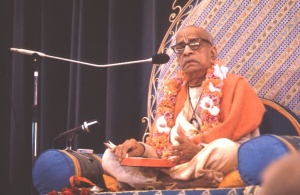SB 1.16.12

A.C. Bhaktivedanta Swami Prabhupada
TEXT 12
- bhadrāśvaṁ ketumālaṁ ca
- bhārataṁ cottarān kurūn
- kimpuruṣādīni varṣāṇi
- vijitya jagṛhe balim
SYNONYMS
bhadrāśvam — Bhadrāśva; ketumālam — Ketumāla; ca — also; bhāratam — Bhārata; ca — and; uttarān — the northern countries; kurūn — the kingdom of the Kuru dynasty; kimpuruṣa-ādīni — a country beyond the northern side of the Himalayas; varṣāṇi — parts of the earth planet; vijitya — conquering; jagṛhe — exacted; balim — strength.
TRANSLATION
Mahārāja Parīkṣit then conquered all parts of the earthly planet—Bhadrāśva, Ketumāla, Bhārata, the northern Kuru, Kimpuruṣa, etc.—and exacted tributes from their respective rulers.
PURPORT
Bhadrāśva: It is a tract of land near Meru Parvata, and it extends from Gandha-mādana Parvata to the saltwater ocean. There is a description of this varṣa in the Mahābhārata (Bhīṣma-parva 7.14-18). The description was narrated by Sañjaya to Dhṛtarāṣṭra.
Mahārāja Yudhiṣṭhira also conquered this varṣa, and thus the province was included within the jurisdiction of his empire. Mahārāja Parīkṣit was formerly declared to be the emperor of all lands ruled by his grandfather, but still he had to establish his supremacy while he was out of his capital to exact tribute from such states.
Ketumāla: This earth planet is divided into seven dvīpas by seven oceans, and the central dvīpa, called Jambūdvīpa, is divided into nine varṣas, or parts, by eight huge mountains. Bhārata-varṣa is one of the above-mentioned nine varṣas, and Ketumāla is also described as one of the above varṣas. It is said that in Ketumāla varṣa, women are the most beautiful. This varṣa was conquered by Arjuna also. A description of this part of the world is available in the Mahābhārata (Sabhā 28.6).
It is said that this part of the world is situated on the western side of the Meru Parvata, and inhabitants of this province used to live up to ten thousand years (Bhīṣma-parva 6.31). Human beings living in this part of the globe are of golden color, and the women resemble the angels of heaven. The inhabitants are free from all kinds of diseases and grief.
Bhārata-varṣa: This part of the world is also one of the nine varṣas of the Jambūdvīpa. A description of Bhārata-varṣa is given in the Mahābhārata (Bhīṣma-parva, Chapters 9 and 10).
In the center of Jambūdvīpa is Ilāvṛta-varṣa, and south of Ilāvṛta-varṣa is Hari-varṣa. The description of these varṣas is given in the Mahābhārata (Sabhā-parva 28.7-8) as follows:
- nagarāṁś ca vanāṁś caiva
- nadīś ca vimalodakāḥ
- puruṣān deva-kalpāṁś ca
- nārīś ca priya-darśanāḥ
- adṛṣṭa-pūrvān subhagān
- sa dadarśa dhanañjayaḥ
- sadanāni ca śubhrāṇi
- nārīś cāpsarasāṁ nibhāḥ
It is mentioned here that the women in both these varṣas are beautiful, and some of them are equal to the Apsarās, or heavenly women.
Uttarakuru: According to Vedic geography the northernmost portion of Jambūdvīpa is called Uttarakuru-varṣa. It is surrounded by the saltwater ocean from three sides and divided by Śṛṅgavān Mountain from the Hiraṇmaya-varṣa.
Kimpuruṣa-varṣa: It is stated to be situated north of the great Himalaya Mountain, which is eighty thousand miles in length and height and which covers sixteen thousand miles in width. These parts of the world were also conquered by Arjuna (Sabhā 28.1-2). The Kimpuruṣas are descendants of a daughter of Dakṣa. When Mahārāja Yudhiṣṭhira performed a horse sacrifice yajña, the inhabitants of these countries were also present to take part in the festival, and they paid tributes to the Emperor. This part of the world is called Kimpuruṣa-varṣa, or sometimes the Himalayan provinces (Himavatī). It is said that Śukadeva Gosvāmī was born in these Himalayan provinces and that he came to Bhārata-varṣa after crossing the Himalayan countries.
In other words, Mahārāja Parīkṣit conquered all the world. He conquered all the continents adjoining all the seas and oceans in all directions, namely the eastern, western, northern and southern parts of the world.